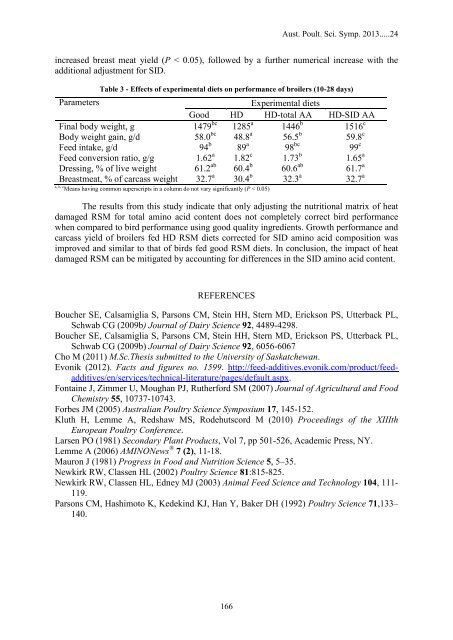APSS 2013 Proceedings - The University of Sydney
APSS 2013 Proceedings - The University of Sydney
APSS 2013 Proceedings - The University of Sydney
Create successful ePaper yourself
Turn your PDF publications into a flip-book with our unique Google optimized e-Paper software.
Aust. Poult. Sci. Symp. <strong>2013</strong>.....24<br />
increased breast meat yield (P < 0.05), followed by a further numerical increase with the<br />
additional adjustment for SID.<br />
Table 3 - Effects <strong>of</strong> experimental diets on performance <strong>of</strong> broilers (10-28 days)<br />
Parameters<br />
Experimental diets<br />
Good HD HD-total AA HD-SID AA<br />
Final body weight, g 1479 bc 1285 a 1446 b 1516 c<br />
Body weight gain, g/d 58.0 bc 48.8 a 56.5 b 59.8 c<br />
Feed intake, g/d 94 b 89 a 98 bc 99 c<br />
Feed conversion ratio, g/g 1.62 a 1.82 c 1.73 b 1.65 a<br />
Dressing, % <strong>of</strong> live weight 61.2 ab 60.4 b 60.6 ab 61.7 a<br />
Breastmeat, % <strong>of</strong> carcass weight 32.7 a 30.4 b 32.3 a 32.7 a<br />
a, b, c Means having common superscripts in a column do not vary significantly (P < 0.05)<br />
<strong>The</strong> results from this study indicate that only adjusting the nutritional matrix <strong>of</strong> heat<br />
damaged RSM for total amino acid content does not completely correct bird performance<br />
when compared to bird performance using good quality ingredients. Growth performance and<br />
carcass yield <strong>of</strong> broilers fed HD RSM diets corrected for SID amino acid composition was<br />
improved and similar to that <strong>of</strong> birds fed good RSM diets. In conclusion, the impact <strong>of</strong> heat<br />
damaged RSM can be mitigated by accounting for differences in the SID amino acid content.<br />
REFERENCES<br />
Boucher SE, Calsamiglia S, Parsons CM, Stein HH, Stern MD, Erickson PS, Utterback PL,<br />
Schwab CG (2009b) Journal <strong>of</strong> Dairy Science 92, 4489-4298.<br />
Boucher SE, Calsamiglia S, Parsons CM, Stein HH, Stern MD, Erickson PS, Utterback PL,<br />
Schwab CG (2009b) Journal <strong>of</strong> Dairy Science 92, 6056-6067<br />
Cho M (2011) M.Sc.<strong>The</strong>sis submitted to the <strong>University</strong> <strong>of</strong> Saskatchewan.<br />
Evonik (2012). Facts and figures no. 1599. http://feed-additives.evonik.com/product/feedadditives/en/services/technical-literature/pages/default.aspx.<br />
Fontaine J, Zimmer U, Moughan PJ, Rutherford SM (2007) Journal <strong>of</strong> Agricultural and Food<br />
Chemistry 55, 10737-10743.<br />
Forbes JM (2005) Australian Poultry Science Symposium 17, 145-152.<br />
Kluth H, Lemme A, Redshaw MS, Rodehutscord M (2010) <strong>Proceedings</strong> <strong>of</strong> the XIIIth<br />
European Poultry Conference.<br />
Larsen PO (1981) Secondary Plant Products, Vol 7, pp 501-526, Academic Press, NY.<br />
Lemme A (2006) AMINONews ® 7 (2), 11-18.<br />
Mauron J (1981) Progress in Food and Nutrition Science 5, 5–35.<br />
Newkirk RW, Classen HL (2002) Poultry Science 81:815-825.<br />
Newkirk RW, Classen HL, Edney MJ (2003) Animal Feed Science and Technology 104, 111-<br />
119.<br />
Parsons CM, Hashimoto K, Kedekind KJ, Han Y, Baker DH (1992) Poultry Science 71,133–<br />
140.<br />
166
















